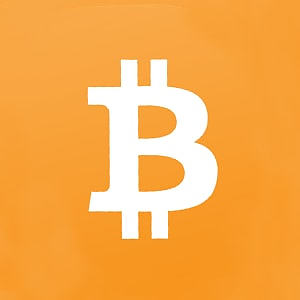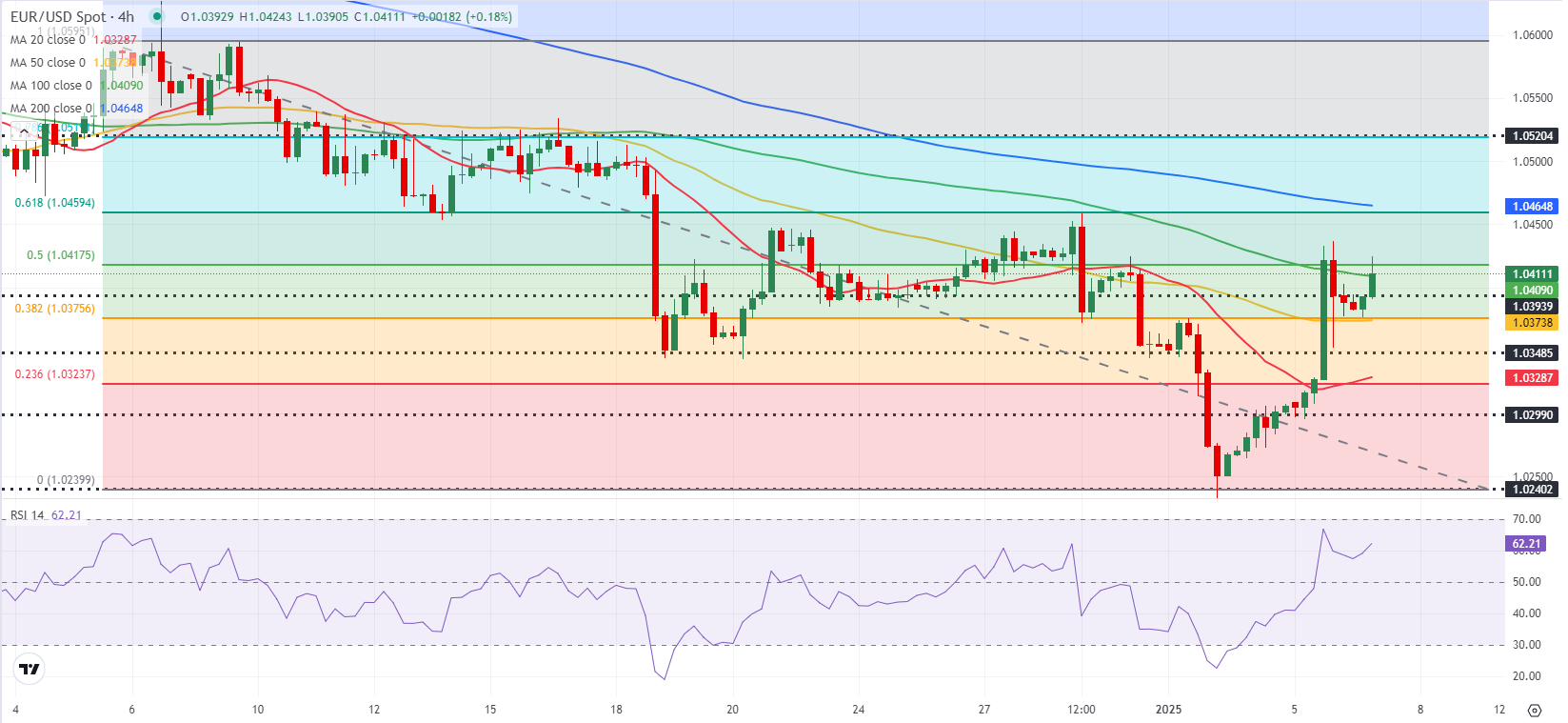- EUR/USD trades in positive territory above 1.0400 on Tuesday.
- The pair could extend its uptrend once it flips 1.0410-1.0420 into support.
- Eurozone inflation report and US data will be watched closely by market participants.
EUR/USD started the week on a bullish note and registered strong gains on Monday as the US Dollar (USD) remained under persistent selling pressure throughout the day. The pair holds its ground and trades in positive territory above 1.0400 in the European morning on Tuesday.
Euro PRICE This week
The table below shows the percentage change of Euro (EUR) against listed major currencies this week. Euro was the strongest against the Japanese Yen.
| USD | EUR | GBP | JPY | CAD | AUD | NZD | CHF | |
|---|---|---|---|---|---|---|---|---|
| USD | -0.98% | -1.00% | 0.25% | -0.96% | -0.87% | -1.00% | -0.52% | |
| EUR | 0.98% | -0.01% | 1.23% | 0.08% | 0.16% | 0.03% | 0.51% | |
| GBP | 1.00% | 0.01% | 1.27% | 0.11% | 0.18% | 0.05% | 0.53% | |
| JPY | -0.25% | -1.23% | -1.27% | -1.21% | -1.10% | -1.22% | -0.54% | |
| CAD | 0.96% | -0.08% | -0.11% | 1.21% | 0.02% | -0.08% | 0.42% | |
| AUD | 0.87% | -0.16% | -0.18% | 1.10% | -0.02% | -0.13% | 0.35% | |
| NZD | 1.00% | -0.03% | -0.05% | 1.22% | 0.08% | 0.13% | 0.48% | |
| CHF | 0.52% | -0.51% | -0.53% | 0.54% | -0.42% | -0.35% | -0.48% |
The heat map shows percentage changes of major currencies against each other. The base currency is picked from the left column, while the quote currency is picked from the top row. For example, if you pick the Euro from the left column and move along the horizontal line to the US Dollar, the percentage change displayed in the box will represent EUR (base)/USD (quote).
The USD weakened against its rivals on Monday in reaction to the Washington Post report that said US President-elect Donald Trump's aides were considering tariffs that would be applied to every country but only cover critical imports.
Although Trump disputed this claim by calling the story "just another example of fake news," the USD failed to stage a decisive rebound as risk flows dominated the market action.
Eurostat will publish December inflation data on Tuesday. On a yearly basis, the Harmonized Index of Consumer Prices (HICP) is forecast to rise 2.4% in December, up from the 2.2% increase recorded in November. A stronger increase than expected in the annual HICP could help the Euro preserve its strength.
In the second half of the day, the ISM Services PMI report for December and JOLTS Job Openings data for November will be featured in the US economic docket. The headline ISM Services PMI is seen rising to 53 from 52.1 in November. A reading below 50 could trigger another bout of USD selloff and lift EUR/USD. On the other hand, a print of 55 or higher could help the USD find a foothold and limit the pair's upside.
EUR/USD Technical Analysis
The Relative Strength Index (RSI) indicator on the 4-hour chart holds above 60, reflecting the bullish bias in the near term. The Fibonacci 50% retracement level of the latest downtrend and the 100-period Simple Moving Average (SMA) form a key resistance area at 1.0410-1.0420. In case EUR/USD rises above this area and starts using it as support, 1.0460 (200-period SMA; Fibonacci 61.8% retracement) could be seen as next resistance before 1.0520 (Fibonacci 78.6% retracement).
Looking south, supports could be spotted at 1.0370 (50-period SMA, Fibonacci 38.2% retracement) and 1.0320 (Fibonacci 23.6% retracement, 20-period SMA).
Euro FAQs
The Euro is the currency for the 19 European Union countries that belong to the Eurozone. It is the second most heavily traded currency in the world behind the US Dollar. In 2022, it accounted for 31% of all foreign exchange transactions, with an average daily turnover of over $2.2 trillion a day. EUR/USD is the most heavily traded currency pair in the world, accounting for an estimated 30% off all transactions, followed by EUR/JPY (4%), EUR/GBP (3%) and EUR/AUD (2%).
The European Central Bank (ECB) in Frankfurt, Germany, is the reserve bank for the Eurozone. The ECB sets interest rates and manages monetary policy. The ECB’s primary mandate is to maintain price stability, which means either controlling inflation or stimulating growth. Its primary tool is the raising or lowering of interest rates. Relatively high interest rates – or the expectation of higher rates – will usually benefit the Euro and vice versa. The ECB Governing Council makes monetary policy decisions at meetings held eight times a year. Decisions are made by heads of the Eurozone national banks and six permanent members, including the President of the ECB, Christine Lagarde.
Eurozone inflation data, measured by the Harmonized Index of Consumer Prices (HICP), is an important econometric for the Euro. If inflation rises more than expected, especially if above the ECB’s 2% target, it obliges the ECB to raise interest rates to bring it back under control. Relatively high interest rates compared to its counterparts will usually benefit the Euro, as it makes the region more attractive as a place for global investors to park their money.
Data releases gauge the health of the economy and can impact on the Euro. Indicators such as GDP, Manufacturing and Services PMIs, employment, and consumer sentiment surveys can all influence the direction of the single currency. A strong economy is good for the Euro. Not only does it attract more foreign investment but it may encourage the ECB to put up interest rates, which will directly strengthen the Euro. Otherwise, if economic data is weak, the Euro is likely to fall. Economic data for the four largest economies in the euro area (Germany, France, Italy and Spain) are especially significant, as they account for 75% of the Eurozone’s economy.
Another significant data release for the Euro is the Trade Balance. This indicator measures the difference between what a country earns from its exports and what it spends on imports over a given period. If a country produces highly sought after exports then its currency will gain in value purely from the extra demand created from foreign buyers seeking to purchase these goods. Therefore, a positive net Trade Balance strengthens a currency and vice versa for a negative balance.
Information on these pages contains forward-looking statements that involve risks and uncertainties. Markets and instruments profiled on this page are for informational purposes only and should not in any way come across as a recommendation to buy or sell in these assets. You should do your own thorough research before making any investment decisions. FXStreet does not in any way guarantee that this information is free from mistakes, errors, or material misstatements. It also does not guarantee that this information is of a timely nature. Investing in Open Markets involves a great deal of risk, including the loss of all or a portion of your investment, as well as emotional distress. All risks, losses and costs associated with investing, including total loss of principal, are your responsibility. The views and opinions expressed in this article are those of the authors and do not necessarily reflect the official policy or position of FXStreet nor its advertisers. The author will not be held responsible for information that is found at the end of links posted on this page.
If not otherwise explicitly mentioned in the body of the article, at the time of writing, the author has no position in any stock mentioned in this article and no business relationship with any company mentioned. The author has not received compensation for writing this article, other than from FXStreet.
FXStreet and the author do not provide personalized recommendations. The author makes no representations as to the accuracy, completeness, or suitability of this information. FXStreet and the author will not be liable for any errors, omissions or any losses, injuries or damages arising from this information and its display or use. Errors and omissions excepted.
The author and FXStreet are not registered investment advisors and nothing in this article is intended to be investment advice.
Recommended Content
Editors’ Picks

EUR/USD turns lower below 1.0350 after German data
EUR/USD comes under mild selling pressure and eases below 1.0350 in the European session on Wednesday. The pair bears the brunt of an unexpected slowdown in the German manufacturing sector, as the nation's Retail Sales data fail to inspire the Euro. Focus shifts to US ADP data and Fed Minutes.

GBP/USD stays defensive below 1.2500 ahead of key US data, Fed Minutes
GBP/USD stays defensive below 1.2500 in the European trading hours on Wednesday, undermined by a risk-off market sentiment and elevated US Treasury bond yields on increased hawkish Fed bets. Traders look to US data, Fedspeak and FOMC Minutes for fresh trading impulse.

Gold price sticks to modest gains; upside seems limited ahead of FOMC Minutes
Gold price (XAU/USD) sticks to modest intraday gains through the first half of the European session on Wednesday, albeit it lacks bullish conviction and remains below the $2,665 resistance zone retested the previous day.

Bitcoin Price Forecast: BTC edges below $96,000, wiping over leveraged traders
Bitcoin's price continues to edge lower, trading below the $96,000 level on Wednesday after declining more than 5% the previous day. The recent price decline has triggered a wave of liquidations across the crypto market, resulting in $694.11 million in total liquidations in the last 24 hours.

Five fundamentals for the week: Nonfarm Payrolls to keep traders on edge in first full week of 2025 Premium
Did the US economy enjoy a strong finish to 2024? That is the question in the first full week of trading in 2025. The all-important NFP stand out, but a look at the Federal Reserve and the Chinese economy is also of interest.

Best Forex Brokers with Low Spreads
VERIFIED Low spreads are crucial for reducing trading costs. Explore top Forex brokers offering competitive spreads and high leverage. Compare options for EUR/USD, GBP/USD, USD/JPY, and Gold.
